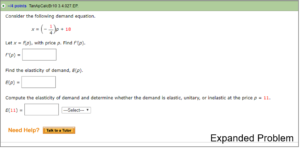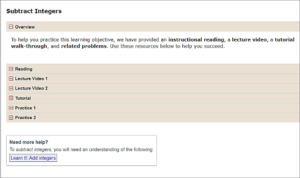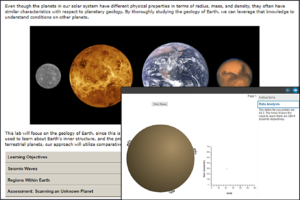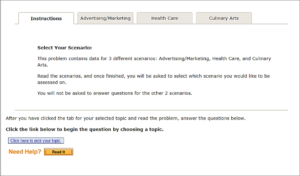We often hear from faculty that you want more questions, more variety and more opportunities to provide innovative content formats to engage students. However, did you know that new questions, resources and content types are added to WebAssign every semester? In fact, a large portion of WebAssign questions go unused. Why is that? One reason could be that many instructors copy their course each semester using the same assignment. They may not know that new questions are available or where to find them.
That’s what we’re here for. Our experts compiled the best WebAssign content types and resources for each course that we think you should use this semester. Learn more about how to incorporate them into your course and how they can improve student learning.
1. Getting Started Questions (All Titles)
Objective: Student Support
Learning a new digital platform and teaching your students how to use it can be a serious time commitment. Which is why you should accept a little help. All courses have access to Getting Started questions packaged into introductory assignments in your Course Packs to introduce students to the features and resources they’ll encounter in WebAssign. Your students will get a step-by-step walkthrough of how to complete graphing, multiple-choice and other types of questions. Plus, they’re personalized to your course content to be most effective for your students.
2. Expanded Problems (Calculus and Applied Calculus)
Objectives: Problem-Solving, Conceptual Understanding

Help students demonstrate their work and better understand their thinking by assigning Expanded Problems (EPs) in your course. EPs require students to show answers to each step necessary to complete the problem so you can pinpoint where students are struggling. They’re useful questions to include in homework or a quiz to ensure students understand the concepts presented.
Expanded Problems are available for: Tan, Harshbarger and Larson titles in Applied Calculus, the 9th editions of Stewart/Clegg/Watson’s Calculus and Calculus: Early Transcendentals. EPs are coming soon to Larson Precalculus titles.
3. Proof Problems (Calculus)
Objectives: Proof Development, Problem-Solving, Conceptual Understanding
Writing proofs helps students show their reasoning skills and construct logical arguments, a critical skill in STEM fields. However, proofs can be challenging to write and grade. To make this process easier, new assignable and automatically graded proof problems in WebAssign enable you to build student confidence and understand proof development in an online environment. Students develop an understanding of the entire process of writing proofs as they get practice and immediate feedback.
Proof problems are available in the 9th editions of Stewart/Clegg/Watson’s Calculus and Calculus: Early Transcendentals as well as Epp’s Discrete Mathematics with Applications, 5e and Poole’s Linear Algebra: A Modern Introduction, 4e.
4. Learn Its (Developmental Math and Corequisite Courses)
Objectives: Independent Learning, Targeted Practice, Student Confidence

Help your students become confident, self-sufficient learners with new Learn It modules. Learn It modules address your students’ prerequisite skill gaps with just-in-time instruction that meets their diverse learning styles. Students will see a Learn It when they’ve incorrectly answered a problem. They gain immediate targeted instruction and practice on that topic using narrative, videos and tutorials—all in one place.
Learn It modules are new for Fall 2021 courses and available in Developmental Math and Math Corequisite courses. To find them in Developmental Math, look for the list of questions located under your instructor resources. For corequisite courses, Learn Its appear in all questions in the prerequisite quiz. They will appear once students get an answer wrong.
5. Optimized Problems (Physics and Astronomy)
Objectives: Problem-Solving, Independent Learning, Cheating Reduction
Discourage students from looking up answers to problems online with Optimized Problems (OPs) for Astronomy and Physics. OPs include comprehensive written solutions to problems with randomized parameters. Because of this, they’re very challenging to find on the internet. Plus, students won’t find these in their textbook. These questions provide targeted feedback to students who’ve incorrectly answered the problem. This helps them understand where they went wrong and how to correct it in the future.
To add OPs to your course, navigate to your question browser and find questions labeled with a “.OP” question tag. They can be found at the chapter level for Serway/Vuille, College Physics & Serway/Jewett, Physics for Scientists and Engineers by selecting a specific chapter and section, and then finding the question labeled “.OP.”
6. Interactive Video Vignettes (Physics)
Objectives: Real-World Application, Conceptual Understanding, Student Engagement
Interactive Video Vignettes (IVVs) are online video analysis and interactive tutorials designed to address prior misconceptions. They set a contextual foundation for Physics students. Students engage with the IVVs, then complete a series of questions about the concept discussed. You can assign IVVs in several ways in various classroom environments: traditional, active or autonomous online learning experiences.
Located in your question browser, IVVs can be found at the chapter level for Serway/Vuille, College Physics, Serway/Jewett, Physics for Scientists and Engineers and Katz, Physics for Scientists and Engineers: Foundations and Connections. You can integrate them into existing assignments with any question type or use them as their own focused assignments.
7. Virtual Astronomy Labs (Astronomy)
Objectives: Conceptual Understanding, Student Engagement

Set the contextual stage for your students with Virtual Astronomy Labs (VALs) which are interactive experiences. VALs combine analysis of astronomical data with simulations and targeted feedback to provide a true online laboratory experience for your introductory Astronomy course.
Located in your question browser, VALs can be found in its own chapter for Seeds/Backman, Horizons: Exploring the Universe, 14e, Serway/Jewett, Seeds/Backman, Foundations of Astronomy, 14e and (OpenStax) Fraknoi/Morrison/Wolff, et al., Astronomy, 1e. You can also add the standalone Virtual Astronomy Labs as a free resource with any other Astronomy title.
8. SALT Tutorial Questions (Statistics)
Objective: Student Support
Help students understand how they can use SALT in their WebAssign assignments with new SALT tutorial questions. These questions help students navigate SALT step-by-step to find the information they need. These tutorials provide students with scaffolded instruction while teaching them how to use SALT to compute and analyze data. These are perfect questions to assign to students at the beginning of an assignment to enhance their understanding.
SALT tutorial questions will be available in most intro Statistics titles this fall. Locate the Digital Content Update Excel document in your instructor resources for a full list of new questions.
9. Select Your Scenario Questions (Statistics)
Objectives: Personalized Learning, Student Engagement

Personalize the learning experience for your students with new Select Your Scenario problems. These problems provide students with 3 different contexts to choose from. Students select the scenario most relevant to them and then solve the problem. Regardless of which scenario the student chooses, they will have to answer questions to demonstrate knowledge of a learning objective. This makes them the perfect questions to assign toward the end of a chapter.
Select Your Scenario problems will be available in most intro Statistics titles this fall. Locate the Digital Content Update Excel document in your instructor resources for a full list of new questions.
10. Responsive Labs (Liberal Arts Math)
Objectives: Personalized Learning, Student Engagement
Personalize the learning experience for your students with new Responsive Labs. These labs are multi-step projects that provide an authentic and personalized application problem. These problems teach learners the skills to apply the mathematics they are learning in various ways outside the classroom. You can assign Responsive Labs both individually in WebAssign and as group work to facilitate collaborative learning.
Responsive Labs are available for the latest editions of the Aufmann titles, Smith, The Nature of Mathematics, 13e, Smith, Mathematics: Its Power and Utility, 10e, and Johnson/Mowry, Mathematics a Practical Odyssey, 8e. Locate the Digital Content Update Excel document in your instructor resources for a full list of new lab questions.
11. Exploring Statistics/Analytics Visualizations (Business Statistics and Analytics)
Objectives: Student Engagement, Conceptual Understanding
Exploring Statistics/Analytics Visualizations (ESAV) engage instructors and students in “lean forward” interactivity to promote a deeper understanding of the information being presented. ESAB was built using a Javascript library that produces dynamic data visualizations in modern web browsers. It offers instructors visual, interactive tools that help students “see” the statistical concept being presented directly within WebAssign.
Located in your question browser, Exploring Statistics/Analytics Visualizations can be found in its own section labeled “Exploring Analytics Applet Exercises” and are available for Anderson/Sweeney/Williams/Camm/Cochran/Fry/Ohlmann Statistics for Business and Economics, 14e, Anderson/Sweeney/Williams/Camm/Cochran/Fry/Ohlmann Essentials of Statistics for Business and Economics, 9e and Camm/Cochran/Fry/Ohlman Business Analytics, 4e.
Take Action
There has been so much uncertainty and endless changes over the last year. We don’t expect you to completely rework your content and assignments. However, even incorporating just one new piece of content or question type will move the needle a little further in making your course the best learning experience for your students.
Start exploring more content types in WebAssign.

